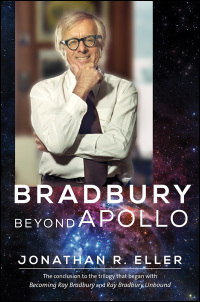A new post to reacquaint File 770 readers with our mottos. No, not the one about the hive! This one — “All Bradbury, All the Time.”
(1) OUT ON A LIMB. Jonathan Stone, in “7 Transformational Books To Read in Your Treehouse” on CrimeReads, discusses seven books he read as a kid in his treehouse. One of the seven is The Martian Chronicles.
(2) THE LAST OF LIFE, FOR WHICH THE FIRST WAS MADE. Jonathan R. Eller’s Bradbury Beyond Apollo is the conclusion to the trilogy that began with Becoming Ray Bradbury and Ray Bradbury Unbound. It will be released in August, and is available for preorder now from the University of Illinois Press.

Celebrated storyteller, cultural commentator, friend of astronauts, prophet of the Space Age—by the end of the 1960s, Ray Bradbury had attained a level of fame and success rarely achieved by authors, let alone authors of science fiction and fantasy. He had also embarked on a phase of his career that found him exploring new creative outlets while reinterpreting his classic tales for generations of new fans.
Drawing on numerous interviews with Bradbury and privileged access to personal papers and private collections, Jonathan R. Eller examines the often-overlooked second half of Bradbury’s working life. As Bradbury’s dreams took him into a wider range of nonfiction writing and public lectures, the diminishing time that remained for creative pursuits went toward Hollywood productions like the award-winning series Ray Bradbury Theater. Bradbury developed the Spaceship Earth narration at Disney’s EPCOT Center; appeared everywhere from public television to NASA events to comic conventions; published poetry; and mined past triumphs for stage productions that enjoyed mixed success. Distracted from storytelling as he became more famous, Bradbury nonetheless published innovative experiments in autobiography masked as detective novels, the well-received fantasy The Halloween Tree and the masterful time travel story “The Toynbee Convector.” Yet his embrace of celebrity was often at odds with his passion for writing, and the resulting tension continuously pulled at his sense of self.
The revelatory conclusion to the acclaimed three-part biography, Bradbury Beyond Apollo tells the story of an inexhaustible creative force seeking new frontiers.
Eller is director of the Center for Ray Bradbury Studies at IUPUI.
(3) BE YOUR OWN GUIDE. At IUPUI’s Center for Ray Bradbury Studies you can “Visit Bradbury’s home office and library!”
One highlight of the Center for Ray Bradbury Studies is its recreation of Ray Bradbury’s basement office and library as it evolved in his Los Angeles, California, home for more than half a century.
The contents of Ray Bradbury’s office and library include more than 100,000 pages of published and unpublished literary works stored in thirty-one of the author’s filing cabinets, forty years of his personal and professional correspondence (over 10,000 pages), author’s copies of his books, including extensive foreign language editions, and his working library (a combined 4000 volumes). The broader collection of papers includes manuscripts, typescripts, screenplay and teleplay drafts, story concepts, photographs, correspondence, scrapbooks with original drawings and printed comic strips from his youth, and ephemera he collected documenting his travels, and more. Also preserved is Bradbury’s original furniture, including his writing desk, paint table, bookshelves, and chairs.
The site also hosts a Virtual Tour of Bradbury’s office. A companion piece is a text-based version of the tour (HTML). Visitors to the site are encouraged to use the text-based version as they navigate the virtual environment.
(4) THE REDISCOVERED COUNTRY. The Paris Review commissioned an interview with Ray Bradbury in the 1970s but it wasn’t completed at the time. Someone found the text in Bradbury’s files, completed the interview, and The Paris Review finally published it in 2010: “Ray Bradbury, The Art of Fiction No. 203”.
INTERVIEWER
The Martian Chronicles, your first major success, was called a novel, but it’s really a book of short stories, many of which had appeared in pulp-fiction magazines during the forties. Why did you decide to collect them as a novel?
BRADBURY
Around 1947, when I published my first novel, Dark Carnival, I met the secretary of Norman Corwin, a big name in radio—a director, writer, and producer. Through her I sent him a copy of Dark Carnival and wrote a letter saying, If you like this book as much as I like your work, I’d like to buy you drinks someday. A week later the phone rang and it was Norman. He said, You’re not buying me drinks, I’m buying you dinner. That was the start of a lifelong friendship. That first time he took me to dinner I told him about my Martian story “Ylla.” He said, Wow, that’s great, write more of those. So I did. In a way, that was what caused The Martian Chronicles to be born.
There was another reason. In 1949, my wife Maggie became pregnant with our first daughter, Susan. Up until then, Maggie had worked full-time and I stayed home writing my short stories. But now that she was going to have the baby, I needed to earn more money. I needed a book contract. Norman suggested I travel to New York City to meet editors and make an impression, so I took a Greyhound bus to New York and stayed at the YMCA, fifty cents a night. I took my stories around to a dozen publishers. Nobody wanted them. They said, We don’t publish stories. Nobody reads them. Don’t you have a novel? I said, No, I don’t. I’m a sprinter, not a marathon runner. I was ready to go home when, on my last night, I had dinner with an editor at Doubleday named Walter Bradbury—no relation. He said, Wouldn’t there be a book if you took all those Martian stories and tied them together? You could call it “The Martian Chronicles.” It was his title, not mine. I said, Oh, my God. I had read Winesburg, Ohio when I was twenty-four years old, in 1944. I was so taken with it that I thought, Someday I’d like to write a book like this, but I’d set it on Mars. I’d actually made a note about this in 1944, but I’d forgotten about it.
I stayed up all night at the YMCA and typed out an outline. I took it to him the next morning. He read it and said, I’ll give you a check for seven hundred and fifty bucks. I went back to Los Angeles and connected all the short stories and it became The Martian Chronicles. It’s called a novel, but you’re right, it’s really a book of short stories all tied together.
(5) MARS AT LAST. Librarypoint covered “A History of Science Fiction: Ray Bradbury & Arthur C. Clarke” in a 2018 article. Its remarks about The Martian Chronicles conclude:
…The final story, “The Million-Year Picnic,” has one of the most powerful images in science fiction: the father of a small family, after burning every document connecting them to their Earthly existence, promises to show his sons “Martians” and introduces them to their own reflections in the canal. The mystery and otherworldly quality of Mars, after being pushed back and civilized for so long under the colonists, is preserved as the immigrants lose their Earthly identity and become the new Martians.
(6) TATTOO ART. All of Me is Illustrated from Rosetta Books matches Bradbury’s fiction and photos of tattooed bodies.

All of Me Is Illustrated is the first book to feature Ray Bradbury’s treasured stories “The Illustrated Man” and “The Illustrated Woman” together alongside the most stunning tattooed bodies of today. Bradbury’s prose reminds us so wonderfully — and at times violently and humorously — how foolish it is to assume the origins and meanings behind a person’s tattoos. Just as with Bradbury’s characters, the motivations of the featured collectors and artists to ink (or be inked) vary. What is undeniable is that their illustrated bodies are a source of pride, wonder, titillation, and beauty, whether depicting the grotesque or the mundane.
…Photographs of renowned tattoo artists and their intricate living pieces are breathtaking companions to Bradbury’s illuminating tales of relationships upended or enriched by the ancient art form. Featured artists include Jessa Bigelow, Paul Booth, Steve Butcher, Ryan Ashley Malarkey, Yomico Moreno, Andy Pho, TeeJ Poole, Duke Riley, DJ Tambe, Tatu Baby, Carlos Torres, Dmitry Troshin, Jess Yen, Popo Zhang. With an introduction by tattoo collector and scholar Anna Felicity Friedman, the result is a book that showcases masters of their craft.
(7) THEATER OF THE MIND. In the Washington Post, Rebecca Powers has a piece on the sounds of travel that has a Ray Bradbury reference. “Even when you can’t travel, you can still bring the sounds of a far-off city to you.”
“In Ray Bradbury’s book, Dandelion Wine, a dying man longs to hear the sounds of Mexico City. He calls a friend there and asks him to hold the phone to an open window so he can hear the ‘hot yellow noon’ of a populated place he once knew. Metal horns, squealing brakes and ‘the calls of vendors selling red-purple bananas and jungle oranges’ travel through the phone line.”
(8) NEWS FROM ME. Mark Evanier introduces videos of his 2004 Bradbury interview on stage at San Diego Comic-Con in this post from 2019. The pair did a Q&A session at several different Comic-Cons. (See also John King Tarpinian’s report and photos of “Ray Bradbury at Comic-Con 41” in 2010.)
…Sometimes, he’d run into an old friend like Julius Schwartz, Forrest Ackerman or Stan Freberg and they’d embrace and catch up on things. If you noticed and recognized him, he was glad to sign whatever you wanted signed and to talk about whatever you wanted to talk about. I’m sure there are many, many folks out there who still treasure those encounters. He had a way of shifting the topic from himself to you. You’d ask him about The Martian Chronicles and wind up talking about what you did or wanted to do for a living.
If you were passionate about something, especially if it was to someday be a writer or artist, he would tell you that you reminded him of himself at your age. That was a powerful feeling he had at the con and he expressed it in so many ways.
…I learned that everything went best when I recalled or researched a great story he’d told many times before and then led him into it. Shortly before the chat below, he’d appeared on a little-watched cable show that Dennis Miller was hosting. Ray started telling a story that was too long for the time remaining so Miller rushed him through it, then cut him off before the punch line. Late in this conversation, I got Ray to tell it in full. Whenever I could steer him into the right tale, it was magic. I just sat there in the best seat in the house and enjoyed Ray Bradbury talking, sometimes at great length. Even at his advanced age, he was one of the best public speakers I’ve ever seen.
- “SDCC 2004 – Mark Evanier interviews Ray Bradbury, Part 1”
- “SDCC 2004 – Mark Evanier interviews Ray Bradbury, Part 2”
- “SDCC 2004 – Mark Evanier interviews Ray Bradbury, Part 3”
[Thanks to John King Tarpinian, Michael Toman, and Martin Morse Wooster for these stories.]
